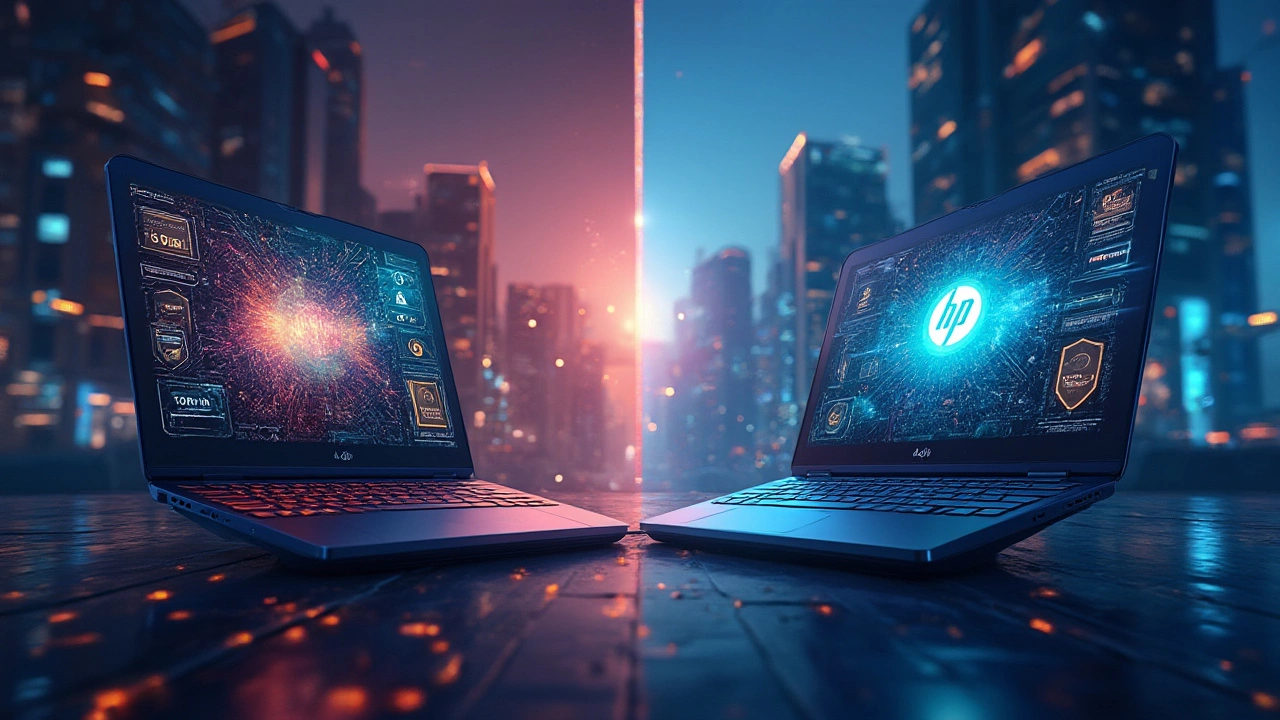
You walk into any electronics store and there it is – the wall of laptops. Sleek shells, glowing screens, price tags everywhere. Dell and HP dominate the shelves, their logos practically daring you to pick a side. Choosing between these two is not just about picking a laptop. It’s about reliability, after-sales support, real-world speed, comfort, and even how your device might look next to a posh coffee in central Brighton. If you think the answer is a simple yes or no, brace yourself. The battle of Dell vs HP isn’t about clear winners. It’s about finding which one fits dell vs hp—your needs, your work, your life.
Design, Build, and User Experience: Look, Feel, and Everyday Use
Laptops these days are as much about personality as performance. Dell leans into the professional, clean-line vibe. Most of their premium models like the XPS 13 feel like a slice of brushed metal perfection, sturdy and minimal, with screens that bleed edge to edge. HP, meanwhile, doesn’t stick to a single design language. Their Spectre line, especially the Spectre x360s, grabs attention with angular edges, gem-cut corners, and bold, blingy hinges. HP’s Pavilion and Envy lines aim at students and home users, with softer curves and lighter casings.
Ever dropped your bag in the train rush? Dell’s business laptops, especially the Latitude series, tend to come out of accidents better. They’re famous for military-standard durability tests—temperature, humidity, vibration—without turning into a brick. HP isn’t too far behind, and in 2023, their Elitebook line started including spill-resistant keyboards and reinforced frames. If you’re tossing your laptop into a rucksack before catching the 7:42 to London, ruggedness might matter more than you think.
Displays deserve a mention. Dell, with its InfinityEdge displays, offers razor-thin bezels. The XPS model, in particular, is a favourite among freelance designers in digital hubs like Brighton’s North Laine because of its 500-nit, near-perfect colour accuracy panels. HP throws serious OLED options into the ring for its high-end notebooks, which means popping colours, pitch blacks, and fantastic HDR streaming when you’re binging shows after hours. A Spectre x360 with OLED is a joy for Netflix marathons—or late-night photo edits.
Comfort is a day-to-day thing. Keyboards on Dell machines are firm, stable, with deeper travel that makes typing all day less tiring. HP’s keys are a bit springier, less noisy. Their trackpads, especially on the Spectre and Envy, have become huge and glass-smooth lately. If you travel a lot, the battery is no joke. Dell’s recent XPS batteries chew through nearly 14 hours in realistic tests done by Laptop Mag in June 2024—even with heavy Chrome tab multitasking. HP’s best, the Elite Dragonfly G4, also hangs around that 13-14 hour range. So you’re rarely eyeing the next wall socket during meetings or classes.
What about ports? Dell made waves (and some enemies) by going minimalist—recent XPS machines ditch standard USB-A for more USB-C and Thunderbolt 4, assuming you’re comfortable with adapters. HP is less brutal; their Spectres and Elitebooks hang onto at least one USB-A, winning points with folks who use flash drives or dongle-free mice.
If you care about recycling, HP has bragging rights—by 2025, 65% of its metal chassis laptops use recycled aluminium. Dell’s Latitude line now uses up to 50% recycled plastics in select parts, including ocean-bound waste. The eco race is tight, but HP’s pushing harder on the green front this year.

Performance, Specs, and Price: What’s Under the Hood Actually Matters
When you want pure muscle under the hood, Dell often goes for raw power and top-tier chips, especially in its gaming and productivity lines. The Alienware series (owned by Dell) is still the darling of the gaming crowd—bright, fast, with RTX 4000 cards and up to Intel Core Ultra or AMD Ryzen 9 CPUs as of July 2025. HP’s Omen series, on the other hand, offers solid gaming performance with slightly better thermals according to PC Gamer reviews this spring, though their maxed-out builds can lag a bit behind Alienware on benchmarks.
For work, things get interesting. Dell’s Latitude and Precision mobile workstations are everywhere in corporate England, popular for reliability and long-term support contracts. They’re built for power users—editors, engineers, financial analysts. HP answers with the ZBook line, which, in 2025, now includes the ZBook Firefly with Intel’s all-new vPro chips and Nvidia RTX Ada workstation graphics. For creative work—video, 3D, big spreadsheets—both are plenty fast, but Dell tends to edge ahead in CPU-heavy benchmarks. The HP ZBook GPUs, though, are famous for holding up in Autodesk and Adobe Creative Cloud tests.
Let’s talk value. Entry-level options from both brands float around the £400-£600 mark: The Dell Inspiron 14 and HP Pavilion 15 both offer Intel Core i5 14th gen or Ryzen 7 8845HS chips in Summer 2025. Don’t expect jaw-dropping performance, but both are enough for study, video meetings, and mid-level multitasking. If you want an SSD that doesn’t crawl, aim for 16GB RAM and at least 512GB SSD, whatever the brand.
When you step into premium builds—Dell XPS 13 Plus or HP Spectre x360 14—you’ll see features like WiFi 6E, Dolby Atmos speakers, facial and fingerprint logins, and touchscreen 3K or 4K displays. Prices are close: The XPS 13 Plus starts at about £1,400; the Spectre x360 often sneaks in just under £1,300. But Dell’s top models offer slightly more GPU or RAM options if you’re looking for longevity.
What about heating and noise? Both have made leaps in cooling. Dell’s dual fan set-ups are quieter than ever, but under heavy loads, HP’s fans seem to spin up less often thanks to smarter “thermal balancing” settings that learn your habits over time. It’s the kind of difference you might notice if you spend all day video-editing or gaming in a shared space.
Here’s something not enough people think about—repairability. Dell puts out detailed service manuals and, for most XPS and business laptops, you can buy official spare parts directly. HP requires you to go through partners for many parts, and some Pavilion/Envy internals are glued or riveted. If swapping your own battery or upgrading RAM is important, Dell is easier. HP’s Elite series is better than their low-end stuff in that respect.
See how the brands stack up head-to-head for some essential 2025 features in the table below:
| Feature | Dell (XPS 13/Latitude) | HP (Spectre/Elitebook) |
|---|---|---|
| Battery Life (avg, real use) | 14 hours | 13.5 hours |
| Screen Options | IPS/3K OLED/4K | IPS/OLED/AMOLED |
| Price (mid-range, July '25) | £900–£1,500 | £850–£1,400 |
| Ports | Thunderbolt 4, USB-C, no USB-A | USB-A, USB-C, HDMI |
| Chassis Materials | Aluminium/plastic (partially recycled) | Recycled aluminium/magnesium |
| Serviceability | Excellent (manuals, easy access) | Good (Elitebooks), Fair (Pavilions) |
| Warranty Option | ProSupport (24/7, on-site help) | Care Pack (phone/on-site) |
Security is no joke, especially with work-from-anywhere life. Both brands toss in TPM 2.0 chips, facial and fingerprint unlocks, optional privacy screens and webcam shutters (on high-end models). But only HP offers the physical e-shutter on most new Spectres, while Dell’s privacy screens are now available on Latitudes and XPS only as upgrades. If you’re typing sensitive stuff in busy cafes, this stuff matters more than you think.

Support, Warranty, and Real-World Longevity: Who’s Got Your Back?
The support question separates the casual user from someone whose job or studies depend on their laptop. Ask any IT admin in Brighton or the student working late in The Lanes—bad support or repairs can turn a good deal into months of stress.
Dell stands out for its ProSupport plans. With next-business-day on-site repair (meaning someone actually comes to you), it’s hard to beat for businesses or freelancing professionals with deadlines. If it’s a hardware fault, their track record for swapping out parts is solid. For students and personal buyers, their basic warranty gives one year, and you can add accidental damage for about £60/year.
HP’s Care Pack options look similar on paper, though their “on-site” often means a pick-up and return rather than fixing your laptop at your house or office. Their remote support staff in the UK have improved, and the online resource centre is now actually navigable if you’re digging for drivers after a late-night Windows update disaster.
From a reliability perspective, both brands have forum horror stories—but so does every laptop maker. Dell’s business lines have slightly lower annual failure rates (2.2% for Latitude in 2024, according to the Q4 Business Laptop Survey by TechUK), compared to HP’s Elitebooks (2.9% for the same period). But home lines (Inspiron, Pavilion) are pretty much neck and neck, hovering around 4% average annual failure. Lesson: Upgrade to the business series if you can. They last longer and get better support.
If you want your laptop to last, here’s a little tip: Don’t skip on cooling. Both brands will last longer if you keep the vents clear, never put your laptop on a thick blanket, and keep software and BIOS updates current. Most folks miss this, then curse the brand when their computer throws a thermal tantrum. HP’s recent BIOS even includes real-time fan health checks now, while Dell’s SupportAssist app checks for firmware upgrades automatically. Use these tools—they do matter.
Customer satisfaction scores tilt slightly in Dell’s favour in the UK in 2025—about 86% satisfaction, up from 81% three years ago, per Which?. HP’s numbers are tight at 84%. Most folks praise both for quick delivery, but complain about long waits for specialist parts or repairs during busy university terms. So if you’re ordering right before term or starting a new job, push for that warranty coverage in writing.
As for resale? Dell’s XPS line keeps value better after two years versus HP’s Spectre, according to eBay’s Q1 2025 resale trends. Business laptops from both fetch a higher percentage back than entry-level models. If you rotate your gear often or like upgrading, this is something worth weighing.
Before you walk out of the shop or click buy, here are a few parting tips:
- Stick to the mid-range or business lines for best reliability—Inspiron, Latitude, XPS for Dell; Pavilion, Elitebook, Spectre for HP.
- Choose at least a 14-inch screen for productivity; travel more, stick with 13-inch.
- Go for minimum 16GB RAM if you want to future-proof—don’t get stuck with non-upgradeable 8GB.
- If USB-A is important, check before buying. Not every Dell has it anymore.
- Push for student, business, or seasonal discounts. Both brands regularly offer up to 20% off, especially before the September school rush.
- Read online user forums for your exact model. Real-world feedback uncovers hidden gems—and recurring pain points.
No brand is “better” in every way, but knowing how Dell outmuscles HP—or the other way round—on durability, design, price, and support can help you land a machine you’ll genuinely enjoy using. That's the stuff that makes the laptop more than just another device. It’s your daily companion, workhorse, and creativity tool, all rolled into one.